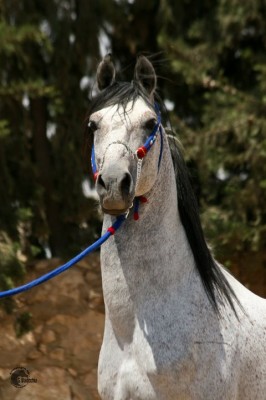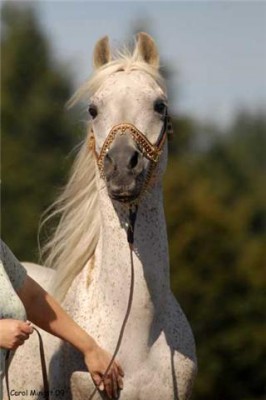Photo of the day: Omeir, Rishan Shar’abi stallion at the Jabri stud in Syria
The photo is part of a series of professional shots which G. Waiditschka took at the stud of Jabri Stud. I don’t know the stallion, nor his strain, but I will call Mustafa to find out. The last time I was there was in 1998 and Omeir was certainly not born yet. That said, he looks to me like a son of Zayn al-Khayl, the Rabdan stallion which Mustafa got from the Tai Bedouins.
Note Omeir’s general likeness to the asil Kuhaylan Haifi stallion Zachary, owned by Diane Lyons in Oregon, USA. Photo below by C. Mingst.


Both Christine Emmert and Carol Mingst were snapping on those photos of Zachary CF, and the one you used is one of Carol’s. They are both excellent photographers!!
Meant to say, this is a son of Zacharia named Zachary CF, out of Recherche. Zachary is owned by Diane Lyons in Oregon.
The link for the professional photos by G. Waiditschka is not working. I like to see more of Mustafa’s horses.
Actually, and I know I’m committing a blasphemy here, but for those of us, who started in Arabian Horses in California, in the 60’s, Zachary’s photo could easily pass for a photo of the head of several of the stallions bred by Alice Payne’ – at least from the front. The beautiful ears, the large wide set eyes and the lovely muzzle.
Alice Payne bred *Raffles horses with multiple crosses to *Raffles, he of course sired by Skowronek. But we know who convinced Charles to considered breeding the Davenports – or at least that is the conventional wisdom – right, Jeanne?
These *Raffles horses were really nice horses, and not necessarily because of Skowronek, IMO.
That’s right; it was Alice Payne and Jimmie Wrench who got Charles going. The conventional wisdom was that there were too few of the Davenports to make a sound breeding group back in the 50s, but Alice & Jimmie encouraged him, and he decided to just let the breeding group show him the way.
Lorriee, I think if you saw Zachary and one of Alice’s horses together in the flesh, they would not look as much alike. She told Charles that she wanted to get down to just the *Urfah line in tail female, because she felt it held up to inbreeding better. So the basis of her inbreeding was early American breeding that was predominantly Davenport.
They still are quite different physically. Bill Munson thought the Davenports were not stout enough. He wanted bigger bones and tendons in the legs, but it seems to me that the Davenports have done alright as they are!
I think Munson was wrong. I have movies of the last of the living *Raffles son’s that I could find, in the 60’s and they were not peas in a pod. Many of this breeding, which I used, included Babson, Davenport, and the real Egyptians’ *Zarife, *Roda and *H.H. Mohammed Ali’s Hamida.
Lady Anne Lytton, told me, in 1972, that Skowronek improved the rear ends of her mother’s horses, but made them flat over the withers. She told me that quite a few of her mother’s horses, before Skowronek were poor in the hind quarters.
Ah, so it’s Skowronek I have to thank for the mutton withers on my old 4H mare. (I will say this, that little partbred could jump the *moon*.)
Loriee: That same general idea has been expressed by many breed observers- that Skowronek improved his descendants butts, but flattened their withers..I suspect that the Skowronek genes had some help from the Hamrah genes in improving the hindends of the the Kellog horses. Especially in light of that famous picture Davenport took of Hamrah as a two year old which shows astonishingly good hindquarters which are stouter than most any other arabian i’ve ever seen pictures of. Referring of course to the annotated quest pictures on page 167.
Best Wishes
Bruce Peek
Lovely head, it reminds me of the heads of these stallions.
http://i262.photobucket.com/albums/ii113/Fekhra/10KuhaylanZaid.jpg
http://img13.imageshack.us/img13/4528/dsc01360o.jpg
ps.
(These horses are Borike arabians)
Few more similar heads
http://i262.photobucket.com/albums/ii113/Fekhra/bonjak062.jpg
http://i49.tinypic.com/dwt7vt.jpg
http://i262.photobucket.com/albums/ii113/Fekhra/bonjak062.jpg
All these stalions are from Kuhlayan Zaid line
This is 76 Mabrouk
http://i262.photobucket.com/albums/ii113/Fekhra/76Mabrouk.jpg
The look of the Arabians, that I saw, in England, in 1972, were best exemplified by the later imported, Count Dorzaz (spl), much more cob looking then the photographs of the Blunt’s horses and the early Crabbet stock. The so-called Straight Egyptian (contemporary) with it’s multiple contacts to the Blunt/Crabbet horses, do not look like the 1972 horses in England. But, then, the SE of today, does not look like Hallany Mistanny, *Nasr and the other Egyptians in the US sans Crabbet blood, prior to the 1958 importations.
So, unless a line is bred within itself, directly from it’s importation from wherever, man tends not only to change the recipe, he also changes the visual outcome.
Argo: Love the photos, they are wonderful.
Yes, they are nice horses
If you want learn mora about these horses just write in google Borike arabian horse.
I wrote in horsegroomingsupplies about these horses.
Sorry for my English and OT.
When I was on April 2008 at Al Jabri farm, I noted the description of this stallion.Mr Walid Khaznah gave me his name as being O’ma-yer A01767 born in 1999 (keheilan Reeshan Sharabi) by Qays A0948 (keheilan Ajuz)son of Marhous and out of Bint Al Badieh A0388 (black)
Bint Al Badieh is not black she was born black she is now grey and her photo is here:
http://daughterofthewind.org/photo-of-the-day-desert-bred-rishah-sharabiyah-syria/
That’s fine.